This special release presents the Palay Production of Cagayan Valley for 2024. The data include the estimates of palay volume of production, area harvested, and yield per hectare for analysis which serves as basis for policy making and for programs and projects on palay farming. The data provided in this special release were taken from the latest available data of the Palay Production Survey (PPS) spearheaded by the Crops Statistics Division, Economic Sector Statistics Service, Sectoral Statistics Office of the Philippine Statistics Authority (PSA). The information presented in this special release was taken from www.openstat.psa.gov.ph.
In 2024, Cagayan Valley's total palay production was recorded at 2,922,717 metric tons (MT), reflecting a 3.4 percent decline compared to the previous year.
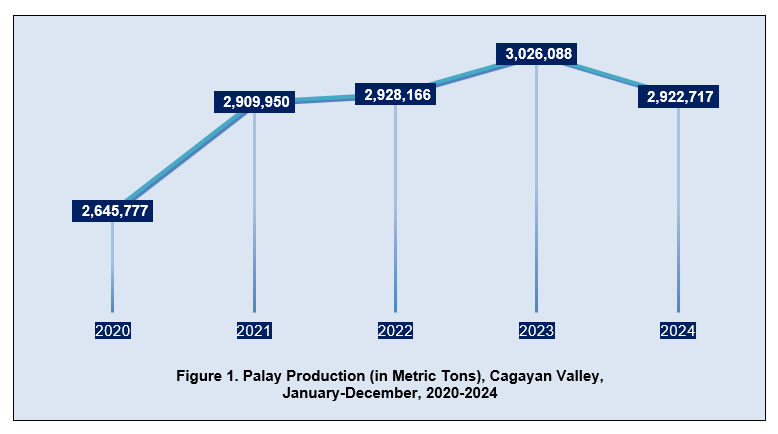
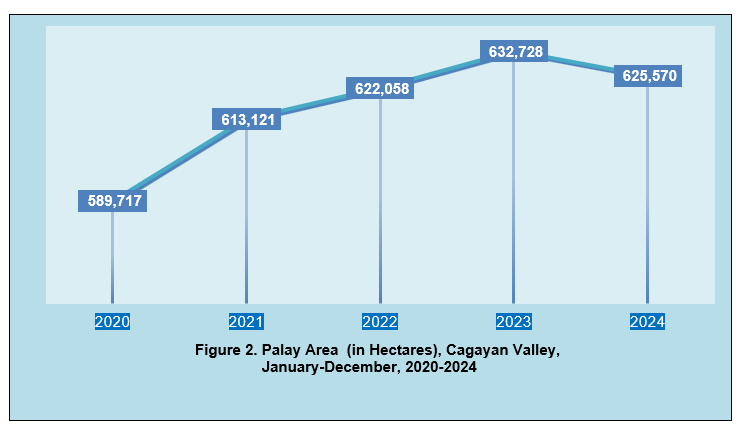
An analysis of the region's production trends from 2020 to 2024 reveals fluctuations, with output peaking in 2023 before declining in 2024. The significant increase in 2021 and the peak in 2023 highlight the region’s potential for high productivity. However, the subsequent drop in 2024 suggests challenges in sustaining this growth.
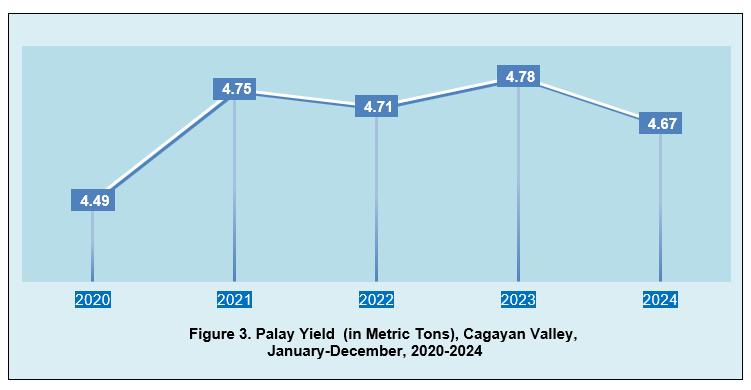
The total area harvested for palay in 2024 was 625,570 hectares (HA), a slight decrease from 632,28 HA in 2023. Thus, the trend shows a gradual increase in the area dedicated to palay cultivation over the five years, with minor fluctuations.
The expansion of cultivated land likely contributed to the increase in production seen in 2021 and 2023. However, the slight reduction in area in 2024, coupled with a decrease in yield, may have led to a decline in total production. Hence, the trends suggest that while expanding the cultivated area is beneficial, other factors like yield per hectare also play a crucial role in determining total production.
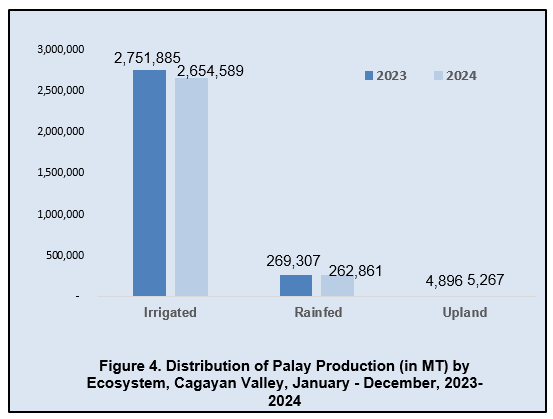
The average yield in 2024 was 4.67 MT/HA, down from 4.78 MT/HA in 2023. This decrease in yield per hectare may have contributed to the overall decline in production.
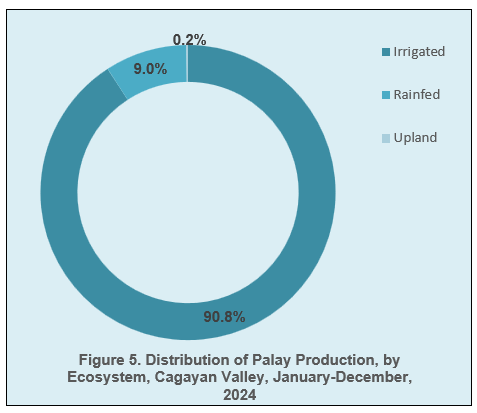
Moreover, the yield per hectare, as shown in Figure 3 highlights the importance of productivity improvements in driving overall production. The peak years of 2021 and 2023 correspond with the highest yields, suggesting that yield gains were a key driver of increased production. As such, the decrease in yield in 2024, despite only a slight reduction in the cultivated area, shows the challenges of maintaining high productivity.
Palay production in irrigated areas remains the most significant contributor, accounting for 2,654,589 MT in 2024, down from 2,751,885 MT in 2023. Rainfed areas produced 262,861 MT in 2024, a slight decrease from 269,307 MT in the previous year. In addition, upland areas saw a marginal increase in production, from 4,896 MT in 2023 5,267 MT in 2024.
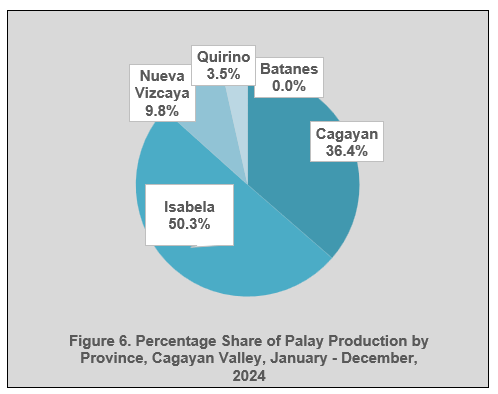
In Batanes, palay production slightly decreased from 80 MT in 2023 to 52 MT in 2024 (Figure 7). The area harvested for palay in Batanes also decreases, from 60 HA in 2023 to 51 HA in 2024 (Figure 8). This decrease in cultivated area may directly correlate with the reduction in production. Thus, the yield per hectare remains relatively stable but reflects a slight drop in efficiency, consistent with the decrease in overall production.

Cagayan saw a more significant drop in production, from 1,127,142 MT in 2023 to 1,063,403 MT in 2024 (Figure 7). The area under cultivation decreased from 245,333 HA in 2023 to 239,232 HA in 2024 (Figure 8). The reduction in area likely contributed to the lower production figures. Moreover, the province’s yield per hectare has also declined, reflecting a less efficient production process in 2024 compared to the previous year.
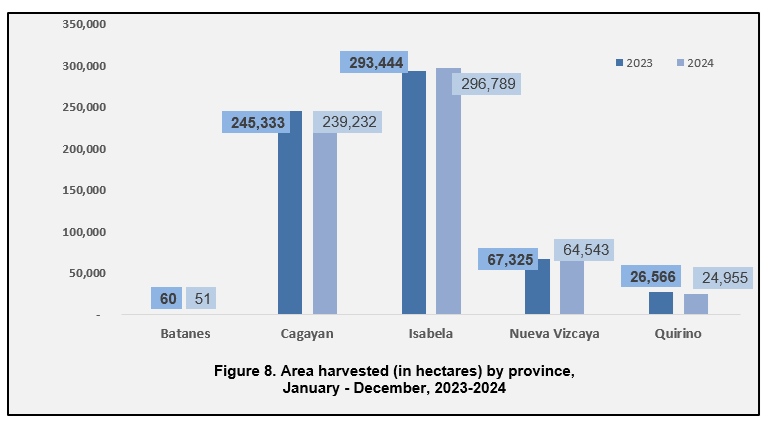
Isabela continues to be the leading producer in the region, though it experienced a slight decline in production from 1,479,190 MT in 2023 to 1,468,910 MT in 2024 (Figure 7). Despite this decrease, Isabela remains the most productive province in the region. The area harvested for palay in Isabela slightly increased from 293,444 HA in 2023 to 296,789 HA in 2024 (Figure 8). The increase in cultivated area may have helped mitigate the decline in production, though not entirely. On the other hand, the yield per hectare in Isabela decreased marginally, suggesting that while more land was cultivated, the efficiency of production was slightly lower in 2024.
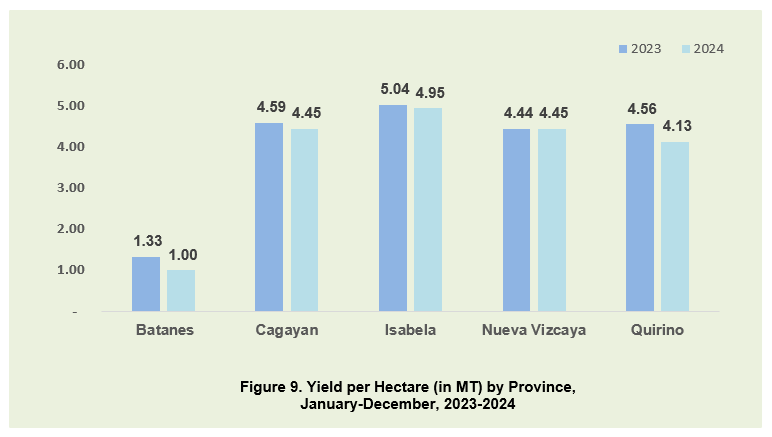
In Nueva Vizcaya, palay production dropped from 298,647 MT in 2023 to 287,210 MT in 2024 (Figure 7). This decline reflects the broader trend of reduced production across the region. The area dedicated to palay in the province also shows a decrease, from 67,325 HA in 2023 to 64,543 HA in 2024 (Figure 8). A reduction in land used for palay cultivation has likely contributed to the drop in production. The yield per hectare in the province increased slightly due to more usage of high yielding varieties.
Quirino province experienced a notable decline in palay production, from 121,029 MT in 2023 to 103,142 MT in 2024 (Figure 7). This represents a significant reduction, highlighting challenges within this province in maintaining stable production levels. Interestingly, despite the decrease in production, the area harvested increased slightly from 26,566 HA in 2023 to 24,955 HA in 2024 (Figure 8).
The palay sector in the Cagayan Valley region experienced a decline in both production and yield in 2024. Despite the reduction in production across some of the ecosystems, the region remains a significant contributor to the national palay output, with Isabela and Cagayan leading in production.
ENGR. GIRME M. BAYUCAN
(Chief Statistical Specialist)
Officer-In-Charge, RSSO II
EMDP/JCB/EKG
TECHNICAL NOTES
Estimates of volume of palay production are generated from the Quarterly Palay Production Survey (PPS) of which there are four survey rounds in a year, that is, January, April, July and October.
The objective of the survey is to generate estimates on palay production. The purpose of this survey is to provide data inputs for policy and programs on rice. The reference and enumeration periods by survey round are as follows:

Definition of terms
Production – refers to the quantity produced and actually harvested during the reference period. It includes those harvested but damaged, stolen, given away, consumed, given as harvester’s share, reserved, etc. Production from seed growers is excluded from the survey.
Irrigated palay – palay area with irrigation facilities that supply water to the farm through gravity, force/power, pump, etc.
Rainfed palay – palay grown in this ecosystem has dikes that retain water and is solely dependent upon rainfall for its water supply.
Upland palay - Palay grown in upland does not have amenities for standing water. It is usually located along elevated lands, along rivers, between hills, hillsides, etc. Upland type is confined not only to high places or hillsides but also to low areas having no facilities for standing water.
